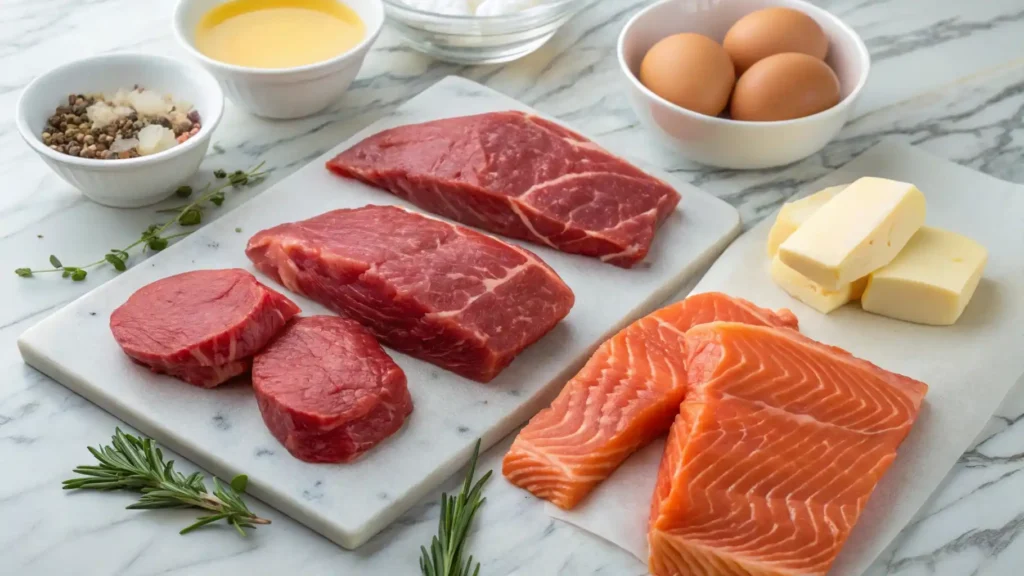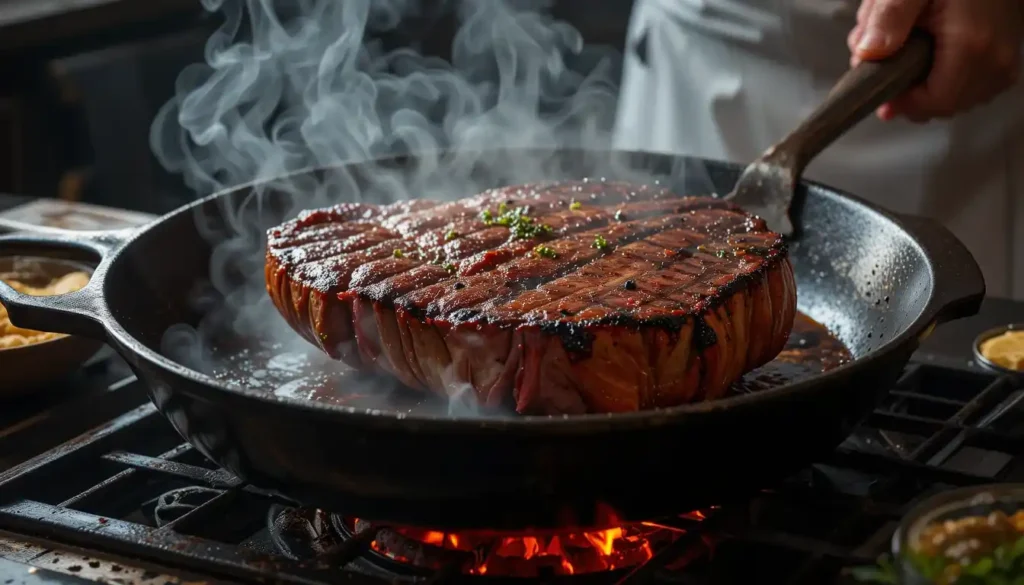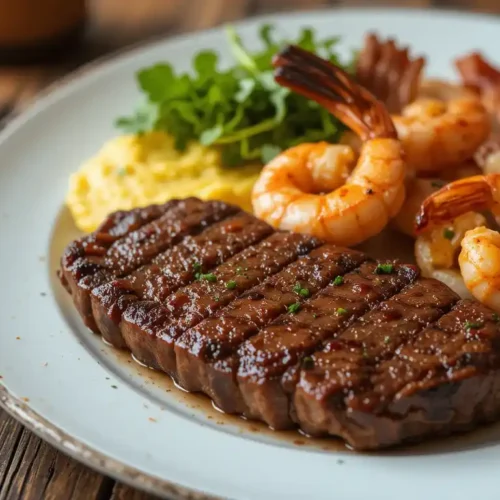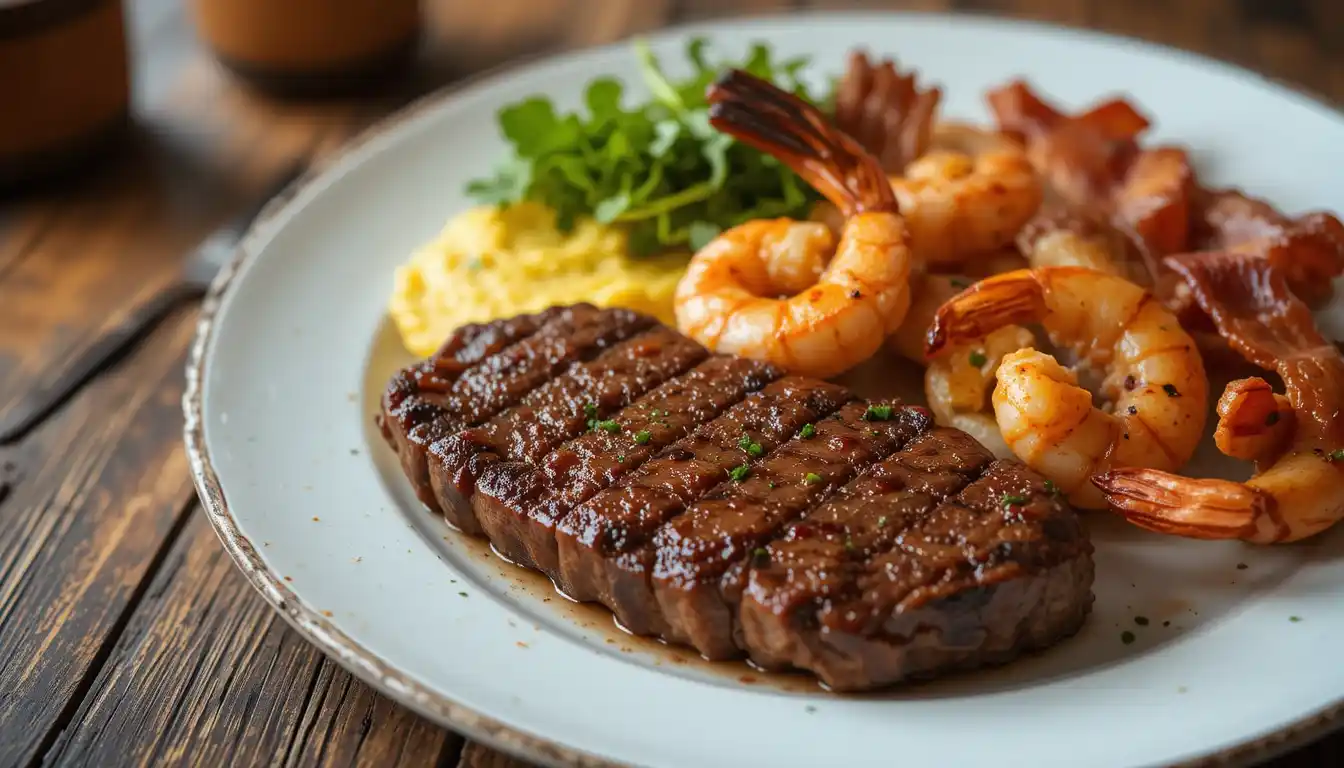Did you know carnivore diet recipes can be both simple and varied, even without plant foods? Joe Rogan lost 12 pounds and felt more energetic after he tried this meat-focused diet for 30 days.
The carnivore diet lets you eat only animal products such as beef, chicken, pork, fish, and eggs. This diet works like keto but takes things further by cutting out all carbohydrates. A survey of 2,000 people who stuck to this diet for 9-20 months showed lower BMI, better energy levels, improved sleep, and greater strength.
Quality matters a lot in a carnivore diet meal plan. Grass-fed meats and wild-caught seafood make the best choices. The diet promotes “nose-to-tail” eating that includes organ meats with regular cuts. You can create many different meals despite the diet’s limits. Quick recipes like three-ingredient egg pudding take just five minutes, while fancy BBQ shrimp dinners add variety to your menu.
This piece will teach you everything about carnivore diet recipes. You’ll learn to make balanced meals and enjoy this unique way of eating without confusion. Let’s tuck into the meat of the matter!
Table of contents
Understanding the Carnivore Diet Food List

The carnivore diet limits your food choices to animal products, creating a zero-carb approach that focuses on protein and fat. You need to know exactly what you can eat to create satisfying recipes and meal plans.
What foods are allowed on the carnivore diet?
Your food choices revolve around animal-based foods. Here are the core foods you can eat:
- Meat: Beef, pork, lamb, chicken, turkey, and game meats like venison are the foundations
- Organ meats: Liver, heart, kidneys, tongue, and bone marrow pack dense nutrients that your body needs[61]
- Seafood: All fish (salmon, mackerel, trout, tilapia, cod) and shellfish (oysters, shrimp, lobster, clams)[61]
- Eggs: These versatile staples give you protein, healthy fats, and essential vitamins
- Animal fats: Butter, lard, tallow, ghee, and bone broth add flavor to your cooking[61][71]
- Select dairy: Low-lactose options like butter, heavy cream, and hard cheese work best[52]
- Seasonings: Salt is crucial, and some versions let you use spices like pepper, garlic, and herbs[72]
Your carnivore diet recipes should feature fatty cuts of meat like ribeye, NY strip, and 80/20 ground beef. These provide energy since you won’t be eating carbohydrates.
Foods to limit or avoid even within carnivore guidelines
The diet has some restrictions even within animal-based foods:
Dairy products can cause problems because of their carbs or inflammatory effects. You should limit or avoid high-lactose dairy like milk and soft cheeses[61]. Many people cut out all dairy at first, then slowly add low-lactose options as their body adjusts.
Processed meats with additives, nitrates, nitrites, or MSG don’t align with the diet’s clean food focus. You should eat bacon and sausage sparingly.
The carnivore diet eliminates all plant-based foods completely:
This means no fruits, vegetables, grains, legumes, nuts, seeds, plant oils, sugars (even natural ones), or alcoholic beverages[52]. This is just a part of what makes the carnivore diet truly “zero carb”. All your fat comes from animal foods.
Building Your First Carnivore Diet Meal Plan
Creating an effective carnivore diet meal plan needs a balance of macronutrients and proper nutrition despite limited food choices. Here’s how you can make satisfying meals with a practical guide to start your carnivore trip.
How to balance meals for satiety and nutrition
The best results on a carnivore diet come from following a macronutrient ratio like ketogenic approaches: about 70-80% of calories from fat, 15-30% from protein, and almost zero carbs. Your body burns fat instead of carbohydrates in this high-fat approach, leading to ketosis.
Natural balance comes from fatty cuts of meat like ribeye, NY strip steak, and 80/20 ground beef instead of lean options. You need at least 1 pound of meat daily for every 100 pounds of body weight to meet protein requirements.
Organ meats boost your nutrient intake significantly. Just 2-3 ounces of liver weekly provides essential vitamins A, D, and B12 that muscle meats might lack. Bone broth adds minerals and collagen to support your joint health and digestion.
Sample 3-day carnivore diet meal plan for beginners
Day 1
- Breakfast: Scrambled eggs cooked in butter with a side of bacon
- Lunch: Ribeye steak
- Dinner: Grilled chicken thighs
- Snack options: Cheese sticks or hard-boiled eggs
Day 2
- Breakfast: Pork sausage patties
- Lunch: Salmon filets
- Dinner: Lamb chops
- Snack options: Sardines or beef jerky
Day 3
- Breakfast: Eggs and bacon
- Lunch: Bone broth soup with shredded chicken thigh meat
- Dinner: Bison steak with sautéed shrimp
- Snack options: Bacon strips or yogurt (if tolerated)
Your body’s hunger signals matter most. The carnivore approach doesn’t need specific meal timing or calorie counting—eat when hungry until satisfied.
Keep things simple at the start. Stick to simple, animal-based meals that you can prepare easily. This helps build consistency as your body adapts to this new way of eating.
Mastering Basic Carnivore Diet Recipes
The carnivore diet’s recipes shine through their simplicity. You need just a few animal-based ingredients and simple cooking techniques. But this doesn’t mean you’ll get stuck eating the same boring meals.
Simple breakfast ideas: eggs, bacon, and more

Your mornings can be filled with many delicious options beyond plain bacon and eggs. Bacon and egg cups make a quick morning meal. Just line muffin tins with partially cooked bacon, crack an egg inside each cup, add salt, and bake for 12-15 minutes at 400°F.
The carnivore egg-in-a-hole gives you a tasty twist by using ground beef instead of bread. Shape ground beef into a patty, make a hole in the center, fry it up, and drop an egg in the middle.
Need something more filling? Steak and eggs or “breakfast meatza” will do the trick. This meat-based pizza substitute topped with eggs and cheese packs enough protein and fat to stimulate your day.
Easy lunch and dinner recipes with minimal ingredients
Lunch and dinner can be just as tasty and straightforward. Air fryer steak bites give you quick protein with easy cleanup, and BBQ shrimp adds seafood variety to your menu.
Ground beef stroganoff made purely from animal-based ingredients hits the spot when you want something heartier. A simple 4-ingredient combo of ground beef, eggs, bacon, and salt makes comfort food under $2 per serving.
Dijon mustard salmon or simple tuna dishes take minutes to make and give you those essential omega-3 fatty acids.
Quick carnivore snacks to stay on track
Hard-boiled eggs make perfect protein-packed snacks. They last a week in the fridge and need minimal prep.
Pork rinds give you that satisfying crunch without carbs. They don’t need refrigeration, which makes them perfect to take anywhere. Bone broth keeps you fed with collagen, gelatin, and amino acids that help your joints and gut stay healthy between meals.
Hard aged cheeses like parmesan or swiss work great if dairy sits well with you. They pack good fat content and minimal lactose.
Essential Cooking Tips for Carnivore Success
Learning to cook meat properly can turn basic carnivore recipes into amazing meals that keep you full longer. Your meat quality and preparation techniques really matter since you’re working with fewer ingredients.
Choosing the right cuts of meat
Red meat with plenty of fat should be the foundation of your carnivore meal plan. Your best results will come from cuts where fat content matches or exceeds protein content by gram. Animals like cattle and sheep provide better nutrition because their digestive systems convert harmful seed oils and plant toxins into healthy saturated fats.
Prime picks for your carnivore diet food list:
Ribeye is the ultimate steak choice, packed with marbling that brings both taste and nutrients. Chuck roast gives you great value—its rich collagen breaks down during slow cooking and creates tender meat that falls apart. Ground beef (80/20 fat ratio) makes an affordable everyday option that’s versatile enough for many dishes.
Organ meats deserve special attention. Liver ranks among the most nutrient-rich foods you can find, while heart gives you plenty of CoQ10 for energy.
Best cooking methods: grilling, searing, roasting

Searing is a crucial technique you’ll need to master. Heat your stainless steel or cast iron pan until it’s very hot before adding fat and meat. Steaks need 2-4 minutes per side, depending on their thickness and how well done you like them.
Restaurant-quality results come from reverse searing. Start your meat in a low oven (around 275°F) until it’s about 10-15 degrees below your target temperature. A quick hot sear at the end creates a perfect crust.
Grilling brings out meat’s natural flavors through caramelization without needing extra ingredients. This works great with steaks, chicken, and seafood, adding smoky depth naturally.
Roasting larger cuts takes some practice but yields great results. A meat thermometer helps you learn the right internal temperatures for your preferred doneness.
How to add flavor without plant-based ingredients
Salt is the life-blood of carnivore seasoning that enhances meat’s natural flavors without adding carbs. Different varieties like sea salt or Himalayan pink salt can add subtle flavor changes.
Animal fats make excellent cooking mediums that add rich flavors. Each type – butter, tallow, lard, and ghee – brings its own unique taste to your carnivore recipes.
Most carnivore dieters can handle basic seasonings like black pepper, garlic powder, and herbs such as rosemary and thyme. Notwithstanding that, if you think you’re sensitive to these, cut them out completely for at least a week before adding them back one at a time.
Natural flavor boosters include dry aging (which concentrates taste through enzyme processes) and hardwood smoking (adds depth without plant ingredients).
Conclusion
The carnivore diet proves surprisingly versatile despite what seems like a restricted way of eating. This piece explores everything from the basic food list to practical meal planning and cooking techniques. Quality makes all the difference—grass-fed meats, wild-caught seafood, and nutrient-dense organ meats create the foundation for optimal health on this diet.
People often fear food boredom when they cut out plant foods. Yet countless recipe options exist. Quick bacon and egg cups, satisfying ribeye steaks, and creative ground beef dishes make this way of eating both simple and enjoyable. The right cooking methods like searing and grilling can substantially improve flavor without plant-based ingredients.
Your experience might differ from others. Some people do well with dairy while others feel better without it. Your ideal fat-to-protein ratio could be different from someone else’s. Success comes from listening to your body and making adjustments that work for you.
For those looking to explore other unique dietary approaches or recipes, you might find the Coffee Loophole Recipe It’s a great way to experiment with new ideas while staying aligned with your nutritional goals.
The carnivore diet brings a radical change for most people. But the benefits many followers report—weight loss, increased energy, better sleep, and boosted strength—make it worth thinking about. You can start with the simple guidelines here and refine your approach as you find what works best for your body.
FAQs
Q1. What is the basic principle of the carnivore diet? The carnivore diet is based on consuming only animal products, primarily meat, fish, eggs, and some dairy. It eliminates all plant-based foods, focusing on high-protein and high-fat animal sources for nutrition.
Q2. How do I start a carnivore diet as a beginner? Begin with simple, nutrient-dense foods like beef, salt, and water. Gradually incorporate other meats, seafood, and eggs. Focus on fatty cuts of meat and listen to your body’s hunger signals. Start with a 30-day trial to allow your body to adapt.
Q3. What are some easy carnivore diet recipes for beginners? Simple recipes include bacon and egg cups, steak and eggs, air fryer steak bites, and ground beef patties. Focus on basic cooking methods like grilling, searing, and roasting to enhance natural meat flavors without added ingredients.
Q4. How can I ensure I’m getting enough nutrients on a carnivore diet? Incorporate a variety of animal products, including organ meats like liver for essential vitamins and minerals. Consider bone broth for additional nutrients. Some people may benefit from electrolyte supplementation, especially during the initial adaptation phase.
Q5. Are there any potential risks or side effects of the carnivore diet? Some people may experience initial adaptation symptoms like fatigue or digestive changes. Long-term concerns include potential nutrient deficiencies, increased cholesterol levels, and effects on gut health. It’s important to monitor your health and consult with a healthcare professional when making significant dietary changes.

Carnivore Diet Basic Meal Plan
Equipment
- Grill
- Cast Iron Pan
Ingredients
- Eggs
- 4 Bacon strips
- 2 lbs Ribeye steak fatty cuts preferred
- 2 tsp Salt to taste
Instructions
- Preheat your grill or cast iron pan to medium-high heat.
- Cook the bacon strips until crispy. Remove and set aside.
- Season the ribeye steak with salt and grill for 3-5 minutes per side until it reaches your desired doneness.
- Meanwhile, fry eggs to your preferred consistency.
- Plate the steak, bacon, and eggs, and serve immediately.



